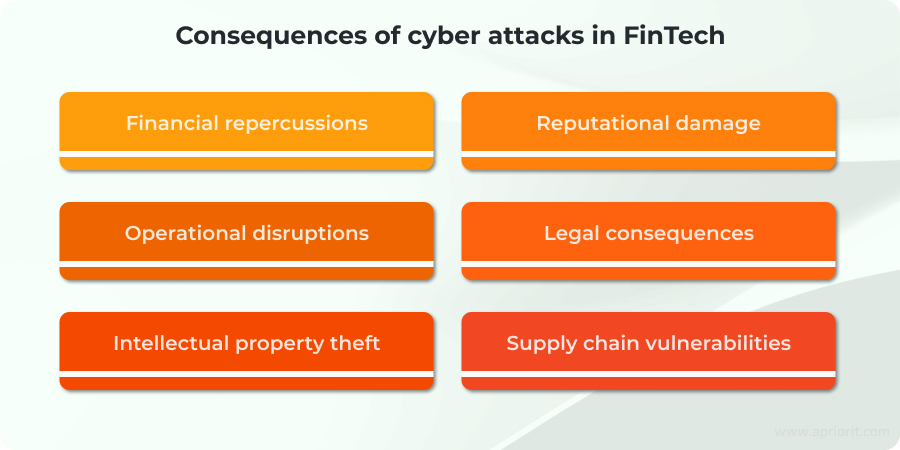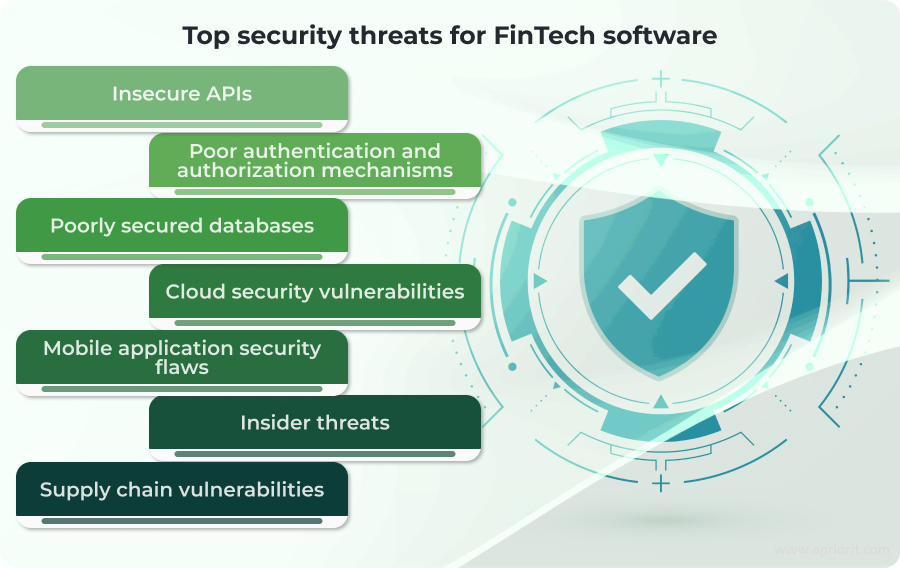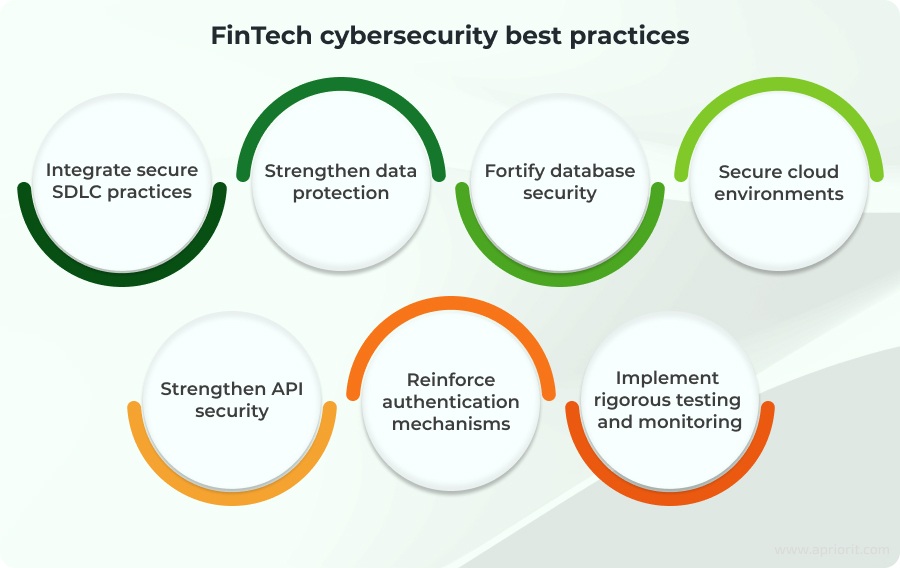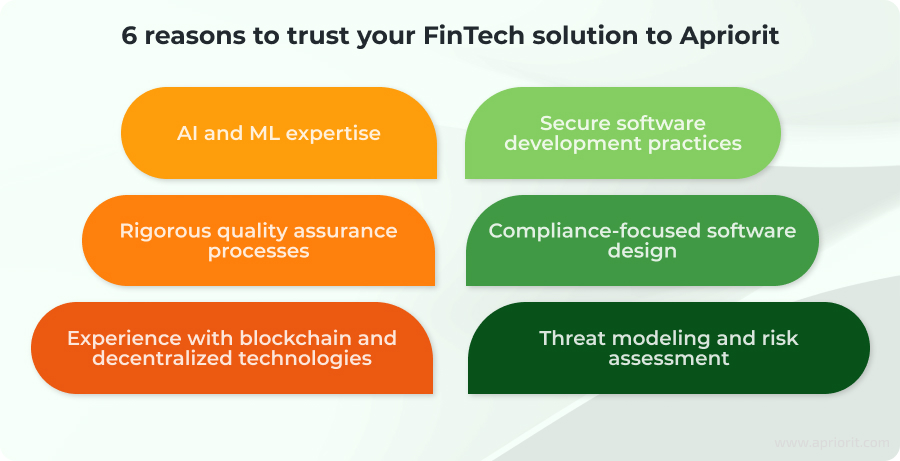Key takeaways:
- The complex nature of FinTech applications creates numerous vulnerabilities that cybercriminals can exploit.
- Due to its interconnected nature, FinTech software has a lot of entry points that attackers can exploit to steal or modify sensitive data.
- Embedding security into software development, cloud infrastructure design, and database planning are key security measures.
- Partnering with experienced cybersecurity specialists helps FinTech companies implement strong security practices, build resilient systems, and ensure regulatory compliance.
The FinTech industry delivers seamless financial services through advanced software. However, this convenience comes with a key challenge — protecting the large volumes of sensitive data within complex software systems. From customers’ financial records to transaction details, FinTech software holds information that is a prime target for cybercriminals.
This article is designed for product managers and software development leaders in the FinTech sector who are looking to boost the security of their projects. Our main goal is to provide a comprehensive overview of common FinTech cybersecurity risks and share proactive measures Apriorit experts use to mitigate them.
By understanding the challenges and implementing best practices to overcome them, you can safeguard your systems, protect customer data, and guarantee business continuity.
Contents:
Why is robust security vital in FinTech software?
The FinTech industry is built on innovation, convenience, and efficiency. Financial software handles high-value transactions in which vast amounts of sensitive data is processed, including banking credentials, credit card numbers, and Social Security numbers. This makes financial software a lucrative target for fraud, theft, and ransomware attacks. And coupled with the quick adoption of technologies like artificial intelligence and machine learning, it creates new and sophisticated entry points for exploitation.
A single FinTech cybersecurity breach can have devastating effects on your business. For example, in November 2024, Finastra, a leading FinTech company serving 45 of the world’s top 50 banks, suffered a major data breach. Approximately 400 GB of sensitive data, including client files and internal documents, was stolen and later circulated on cybercrime forums. While the company stated that there was no direct impact on customer operations or tampering with customer files, the breach raised significant concerns about client confidentiality and data security, as well as the overall importance of cybersecurity in FinTech.
Here are other possible impacts of malicious attacks on FinTech software:

- Financial repercussions. A successful cyber attack can lead to direct financial losses, hefty regulatory fines, and other penalties for non-compliance with mechanisms like PCI DSS standards and the GDPR.
- Reputational damage. Loss of customer trust can be even more costly than financial losses. A high-profile data breach can result in negative press, declining user confidence, and customer churn.
- Operational disruptions. Downtime, resource-intensive recovery efforts, and interruptions to critical services can harm daily operations and customer satisfaction in the long run.
- Legal consequences. Data breaches often result in lawsuits, legal battles, and non-compliance penalties, especially in regions with strict data protection laws like the EU and the US.
- Intellectual property theft. Cyber attacks can target proprietary algorithms, financial models, or other intellectual property, risking a company’s competitive edge.
- Supply chain vulnerabilities. A security breach at your company can impact your partners, potentially leading to operational disruptions and reputational damage for them as well.
These impacts show why robust cybersecurity measures are not just an operational priority but a strategic imperative for any FinTech organization. Let’s see what risks you should be on the lookout for in your FinTech software.
Protect your FinTech services with Apriorit’s expertise!
From secure APIs to advanced cloud architectures, Apriorit specializes in building tailored FinTech solutions designed to safeguard sensitive data and drive innovation.
Common cybersecurity threats in FinTech software
FinTech companies face a wide range of cybersecurity threats that target sensitive financial data, user credentials, and critical infrastructure. Here are some of the most pressing risks FinTech software can face.

Insecure APIs. With the help of APIs, FinTech software can connect with banking systems, third-party services, and mobile applications. However, a single compromised API endpoint can lead to significant data breaches, exposure of financial information, and cybersecurity attacks.
Key attack vectors:
- Man-in-the-middle (MitM) attacks – Intercepted API communication can lead to stolen credentials or financial fraud.
- Inadequate rate limiting – Attackers can exploit APIs to overload services with excessive requests, leading to denial of service.
- Injections – API endpoints that are vulnerable to invalidated input as a result of injection attacks can be exploited to manipulate transactions or extract data.
Poor authentication and authorization mechanisms. Weak or outdated authentication and authorization controls allow attackers to gain unauthorized access to FinTech systems, which in turn can lead to account takeovers, financial fraud, and data breaches.
Key attack vectors:
- Credential stuffing – Attackers use stolen passwords from data breaches to access accounts.
- Brute forcing – Automated scripts attempt to guess login credentials.
- Session hijacking – Attackers intercept session tokens to impersonate users.
Poorly secured databases. Databases store financial transactions and user information, which makes them a prime target for cybercriminals. Poorly secured databases can result in stolen data, financial fraud, or even system compromise.
Key attack vectors:
- SQL and NoSQL injection – Attackers manipulate database queries to extract, delete, or modify sensitive data.
- Privilege escalation – Exploiting weak access controls, like the granting of administrator rights to all users, can help malicious actors gain administrator privileges.
- Security misconfiguration – Poor database settings, such as query permissions, can expose sensitive information to the public.
Cloud security vulnerabilities. Many FinTech solutions rely on cloud services to store and process sensitive financial data. However, misconfigurations and vulnerabilities in cloud environments can expose sensitive information.
Key attack vectors:
- Misconfigured cloud storage – Poorly configured storage settings (such as AWS S3 buckets being left open) can expose financial records, user data, or API keys to public access.
- Unsecured cloud APIs – APIs without proper authentication and encryption can enable attackers to extract or manipulate sensitive financial data.
- Interception of encrypted data – Data stored in plaintext or transmitted over unsecured channels is vulnerable to interception and theft.
Mobile application security flaws. FinTech mobile apps directly access customers’ financial accounts and initiate transactions. This means that vulnerabilities in these mobile apps can expose private data and allow attackers to compromise user accounts.
Key attack vectors:
- Exploitation of insecure data storage – Sensitive data (like login credentials, API keys, or transaction details) that are stored unencrypted on a mobile device can be easily accessed if the device is compromised.
- Interception through insecure communication – Failure to use HTTPS for all communication between the mobile app and backend servers can expose data in transit.
- Reverse engineering and tampering – Attackers can decompile apps to find security flaws or extract API keys.
Insider threats. Employees or contractors with access to sensitive data can pose significant risks, whether through malicious intent or negligence. Since they have legitimate access, it might be challenging to detect and prevent the malicious use of credentials.
Key attack vectors:
- Privileged access abuse – Some insiders with malicious intent can steal customers’ financial data, trade secrets, or intellectual property for personal gain.
- Exploitation of negligent security practices – Employees mishandling confidential data, such as sending sensitive files to the wrong recipient or storing credentials in unsecured locations, can lead to breaches.
Software supply chain vulnerabilities. Your FinTech software is connected to various suppliers, contractors, third-party libraries, and/or development tools. This is why negligent or even malicious actions of your contractors can have serious consequences.
Key attack vectors:
- Tampering with infected software updates – Cybercriminals tamper with legitimate software updates, embedding malware that can steal sensitive data or enable unauthorized access.
- Exploitation of third-party dependencies – Attackers exploit weaknesses in open-source libraries or third-party APIs, creating FinTech app security gaps.
Understanding these common cybersecurity threats in FinTech will help you stay ahead of attackers. However, awareness is only the first step, as organizations must act to protect their systems. Next, we’ll take a look at practical strategies to strengthen the cybersecurity of your FinTech software and stay ahead of potential risks.
Read also
How to Detect Banking Fraud Using Machine Learning
Discover how to build and implement ML-powered fraud detection systems for modern banking needs and regulatory demands.

Proactive measures for boosting the cybersecurity of your FinTech software
At Apriorit, our cybersecurity experts have extensive experience securing FinTech solutions against evolving threats. Below, we share essential best practices to help you enhance your software security and protect sensitive financial data.

Integrate secure SDLC practices. To reduce vulnerabilities, security should be embedded at every stage of the development process, from design to deployment. To implement a secure SDLC, your teams should:
- Conduct threat modeling early in development to identify potential risks
- Use secure coding guidelines such as OWASP’s Secure Coding Practices
- Automate security testing within the CI/CD pipeline
- Apply least privilege access to development and staging environments
- Regularly review dependencies to mitigate supply chain risks
Apriorit expert tip: Adopt shift-left security by implementing secure coding and automating security scans before code reaches production.
Strengthen data protection. Financial data is a valuable target for attackers. Protecting it requires strong encryption, strict access controls, and secure transmission practices. Here is what you can do:
- Encrypt sensitive data both at rest and in transit using AES-256 and TLS 1.3
- Implement tokenization to replace sensitive data with non-sensitive placeholders
- Enforce data access restrictions through role-based or attribute-based access control
- Secure backups with encryption and offline storage to prevent ransomware attacks
- Monitor for unauthorized data access with real-time anomaly detection tools
Apriorit expert tip: Avoid relying solely on encryption. You can combine data masking and access logging to make unauthorized data exfiltration harder to execute and easier to detect.
Fortify database security. Since databases store everything from customer information to financial transactions, attackers aim to exploit their vulnerabilities to access sensitive data or disrupt critical operations. Your teams can:
- Use parameterized queries and ORM libraries to prevent SQL injection attacks
- Enforce strict access controls to limit exposure to sensitive information
- Monitor database activity with real-time logging and anomaly detection
- Regularly apply security patches to database management systems
Apriorit expert tip: Consider implementing database segmentation and read-only replicas to minimize the impact of data breaches.
Secure cloud environments. Cloud infrastructure offers scalability, flexibility, cost efficiency, and seamless services. A secure and well-monitored cloud environment is crucial to keep your sensitive assets safe and to maintain customer trust.
- Implement a zero-trust model that verifies every access request before granting permissions
- Regularly audit identity and access management configurations to prevent privilege escalation
- Encrypt cloud-stored data and use hardware security modules for key management
- Use cloud security posture management tools to detect and fix misconfigurations
- Implement network segmentation to limit exposure of critical systems
Apriorit expert tip: Use infrastructure-as-code scanning to catch misconfigurations before they are deployed to production.
Strengthen API security. Without proper security measures, vulnerabilities such as weak authentication, unvalidated inputs, or insecure communication can leave your FinTech ecosystem vulnerable to attacks. Here is how your teams can boost API security:
- Authenticate API requests using OAuth 2.0 and OpenID Connect
- Use API gateways to enforce rate limits and filter malicious traffic
- Encrypt API communications with TLS 1.3 to prevent eavesdropping
- Implement strong access controls with API keys and JWT-based authentication
- Regularly test APIs for vulnerabilities to injection attacks and broken access control
Apriorit expert tip: Your teams should monitor API traffic for unexpected behavior, such as high-frequency requests from a single IP, which could indicate an upcoming attack.
Reinforce authentication mechanisms. Compromised credentials are one of the biggest threats to FinTech applications. Strong authentication not only acts as the first line of defense but also builds trust with users by ensuring their accounts and financial data are well-protected. To achieve this, you can:
- Require multi-factor authentication for all user and admin accounts
- Implement adaptive authentication, which tightens security based on risk signals
- Use other types of authentication, such as biometrics or security keys
- Enforce strict session management policies to limit unauthorized access
- Monitor authentication logs for unusual login attempts and brute-force attacks
Apriorit expert tip: Dynamically adjusting authentication requirements based on user behavior can provide an additional layer of protection. For example, you might require additional verification for high-value transactions or logins from new devices.
Implement rigorous testing and monitoring. Since security threats evolve every day, your teams should continuously test their defenses and monitor for vulnerabilities in real time to address them before they are exploited. Here is how you can achieve this:
- Perform regular penetration testing to simulate real-world attack scenarios
- Deploy continuous security monitoring using security information and event management (SIEM) and intrusion detection systems
- Automate vulnerability scanning across networks, APIs, and applications
- Use behavior-based threat detection to identify anomalies and prevent fraud
- Establish an incident response plan for fast threat mitigation
Apriorit expert tip: You can invest in AI-driven security analytics to detect unusual activity faster and predict potential attack patterns before they escalate.
Related project
Developing a Custom Secrets Management Desktop Application for Secure Password Sharing and Storage
Keeping sensitive credentials secure is crucial for any business. Discover how we developed a robust secrets management app to protect sensitive data and ensure seamless access control. features.

How can Apriorit help?
Since we specialize in building secure, resilient, and high-performance FinTech solutions, we integrate cybersecurity best practices into every stage of the software development lifecycle. Our team combines deep security expertise, rigorous QA processes, and custom software development to help FinTech companies create secure, scalable, and compliant applications.

Whether you need to build new software or strengthen existing software, we are ready to assist you. Here are examples of what our experts can do:
- Develop a decentralized asset market on the Tezos blockchain. We create cutting-edge decentralized solutions to empower asset trading with enhanced security and transparency.
- Assess smart contract security for DeFi. Our experts can make sure that your smart contracts are secure, compliant, and free of vulnerabilities, building trust in your DeFi solutions.
- Create AWS-based blockchain infrastructure for international banking. We design and implement secure and scalable blockchain ecosystems to streamline global banking operations and ensure data integrity.
We understand that security is not an add-on but an integral part of your software. With our help, you can meet your unique security needs and create innovative, future-proof solutions.
Conclusion
Securing FinTech software is one of the biggest challenges in the industry, as the risks are constantly evolving. Without strong cybersecurity measures, organizations face data breaches, regulatory fines, and reputational damage with long-term consequences. This is why partnering with a trusted technology provider is crucial for staying ahead of these threats.
At Apriorit, we specialize in cybersecurity and software development, offering secure SDLC implementation, rigorous testing, and API development. With a proven history of delivering tailored security solutions for FinTech applications, we help businesses protect their software, secure sensitive data, and maintain customer trust.
Protect your sensitive data, improve operational efficiency, and innovate with confidence.
Apriorit is ready to bring your FinTech project to life. Let’s collaborate to enhance security and exceed your customers’ expectations.



